Negative Capability: Embracing Uncertainty and Celebrating the Mysterious.
In a letter to his brothers, George and Thomas, found in Letters of John Keats to His Family and Friends and dated December 21, 1817, Keats uses the phrase that has come to be the single most emblematic phrase of his entire surviving correspondence, even though he only makes mention of it once: “Negative Capability” — the willingness to embrace uncertainty, live with mystery, and make peace with ambiguity. Triggered by Keats’s disagreement with English poet and philosopher Coleridge, whose quest for definitive answers over beauty laid the foundations for modern-day reductionism, the concept is a beautiful articulation of a familiar sentiment — that life is about living the questions, that the unknown is what drives science, that the most beautiful experience we can have is the mysterious.
Negative Capability made easy through the appeal of images!
What is this man doing with Keats’s concept? How do you relate to “negative capability”? In other words, do you deem it a useful concept to bear in mind in your life? Why (not)?
Negative capability explained in words!
“The wise man questions the wisdom of others because he questions his own, the foolish man, because it is different from his own.” —Leo Stein, American art collector and critic
In an 1817 letter to a friend, the poet John Keats describes one of the qualities that makes writers like Shakespeare so great: negative capability. Keats defines this trait as “…when a man is capable of being in uncertainties, mysteries, doubts, without any irritable reaching after fact and reason.” In other words, this is the ability to sublimate one’s own individual assumptions about the world and write about uncertain (or potentially polarizing) topics in such a way that the author’s own views remain unknown. It is also the recognition that there are often grey areas in life which cannot be resolved through rational means. This requires an extraordinary degree of objectivity, and it’s much harder than it seems. To enter into the mind of other people (or things) and speak from their point of view is an essential goal for writers.Often some of the most engaging literary works are those where there is no clear side taken on contentious issues (such as the free will versus predestination dichotomy in Shakespeare’s Hamlet or Sophocles’ Oedipus Rex). But the question is, how can writers break free from their own personal perceptions and approach subjects from a more objective point of view?
1. Read writers who are good at negative capability: Keats, Shakespeare, and Sophocles. But there are plenty of other notable authors, such as Emily Dickenson, William Wordsworth, Anne Rice, Walt Whitman, and John Updike.
2. Learn to view situations from other people’s perspectives. Imagine not what you would do if you were facing their circumstances, but rather think about what they would do and why.
3. Step into the unknown. Force yourself to write about subjects or situations you are uncomfortable with (or know little about).
4. Write in a new genre. Tell a familiar tale in a different format. Different literary conventions require different sensibilities, and this can lead to breakthroughs in our perceptions of subjects.
One of the joys of reading is having the opportunity to experience situations from someone else’s perspective. To do this convincingly, writers must learn to put aside their own ideas about the world and imagine alternative possibilities. This is terra incognita for many people, but by embracing this approach, you may discover new avenues of creative potential, and this is exactly what KEATS teachers US! He would have been a great creative writing instructor, wouldn’t he?
La Belle Dame Sans Merci
Different painters were inspired by this poem. Look at their works of art. In the light of the analysis of the poem and your reading of it, which painting do you like best? Why? Try to substantiate your choice with references to the poem itself.
John William Waterhouse
Arthur Hughes
Ode on a Grecian Urn
Look at the following videos to learn more about this great, yet difficult, ode.
The BBC webpage has an interesting section dedicated to The Romantics, worth browsing it: you can see the original manuscript too, if you are interested.
I highly suggest you listen to/watch the following lectures on the ode, so that you expose yoruself to different ways of analysing a poem, to different expressions to explain the same concepts. It is good listening comprehension and a good way to expand your vocabulary and hone your listening skill. Which lecture do you like best? Why? As a student, which teacher/lecturer of these would appeal to you the most? Substantiate your choice. We will discuss this point in class together.
Do you agree that art takes its truth from life and then returns it to life as beauty as is suggested in the poem? The poet seems to suggest that only the dead are immortal how are they immortalized?
This is a detailed analysis that I prepared some time ago for other students of mine. I decided to post it here because some of you may find it useful.
BBC Omnibus, 1995 – To commemorate the bicentenary of sublime English poet John Keats, Andrew Motion (now Poet Laureate) recreates the final, futile voyage from England to Italy
If you go to Rome, do not miss the Keats-Shelley house. It is a great place to visit, especially for people like you, who had the chance to study English literature.

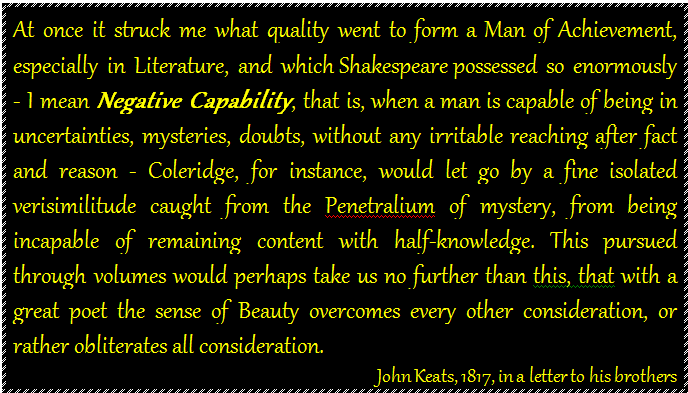

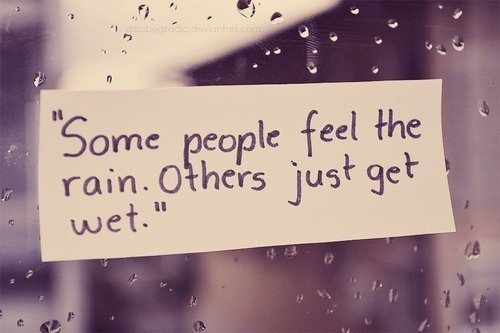
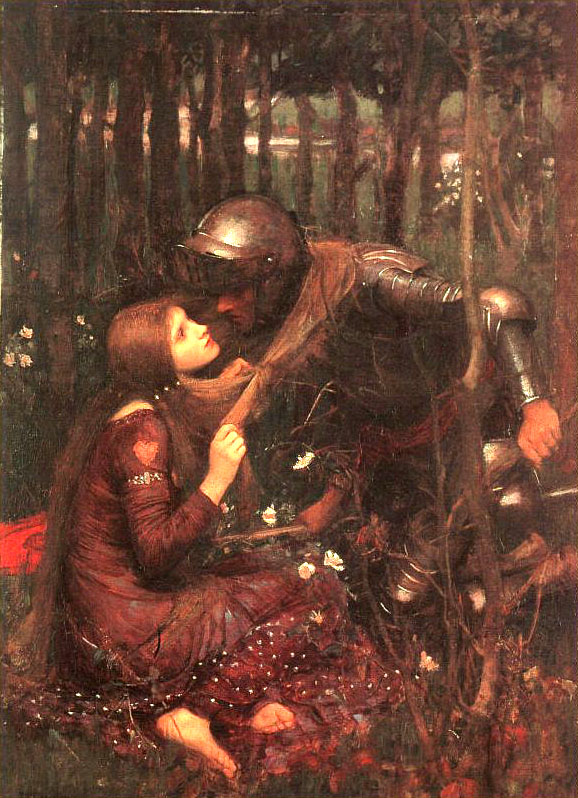

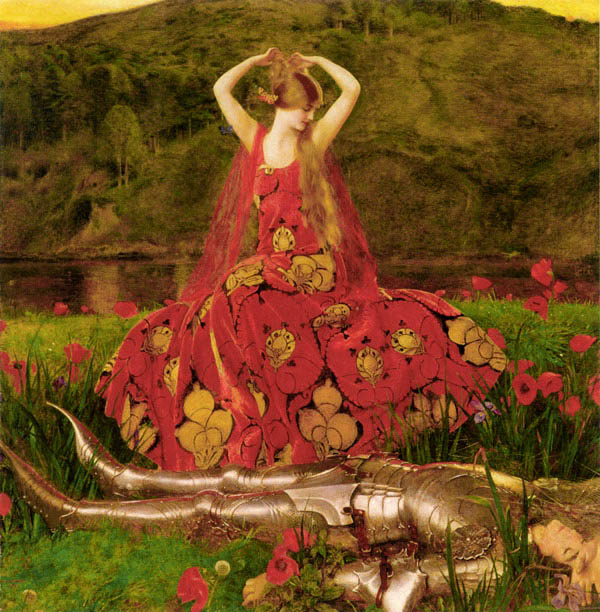
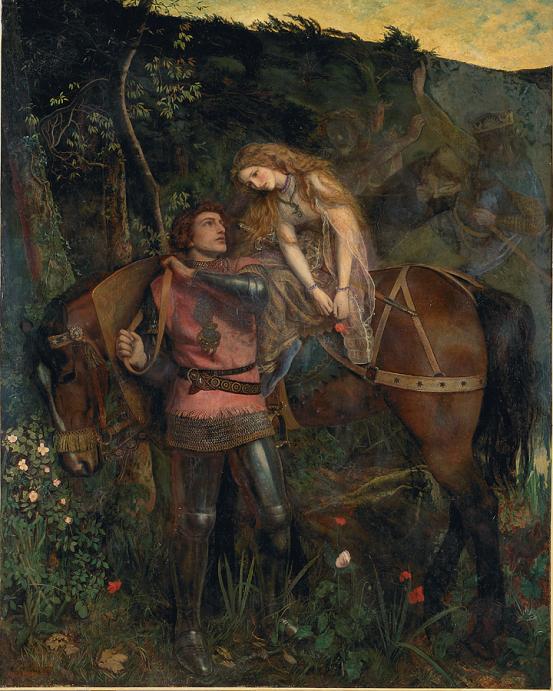

Negative Capability consists in forgetting, for one moment, ourselves and try to expand our identity towards what we are not. Negative Capability, then, should help us to improve our souls, our ‘being human’; if spirits could be represented on a stairway where the more elevated we are the closer we stay to heaven, Negative Capability should help us leaving the ground behind and let us understand better the world where we live and the people we’re surrounded by. I say “should” because through the understanding of others it is possible to have a great power on them; not only businessmen but everyone, if capable of being somebody else, can make everything. Understanding, not defense, is the best attack; because in the deepest places of our nature we all want somebody who is not just a friend to go shopping with, but somebody who is as we are, who is we after all. Negative Capability, then, is like a pen: you can use it to write a beautiful poem or to throw a curse, the decision is up to the person.
I prefer most the painting of Frank Dicksee because of the colors , the setting
of the picture and the fidelity at the ballad. For example this picture is
faithful at the ballad because the girl wears a garland of flowers in her head
or because the girl is on the horse. The figure of the “femme fatale” is noted
by the position of control and superiority of the girl compared to the knight.
The man is totally subjected at the will of the fair, that uses her sexual
power to control the knight. The man is totally submitted to the fair, he is
totally fallen in love for her and he has eyes only for her. I like this
picture because it shows love that would have a tragic consequences. Her look
to him demonstrate her bad intentions. This picture shows the situation when
love is a trap. The attraction can be very strong that it can drag a person
even to death. Finally I prefer this picture because it has a very beautiful
colors, in my point of view, that they bring out the meaning of the scene.
Giulia Bertacco
“Negative capability” is the ability to identify with others, to imagine yourself in their position, to sympathize with the other human beings . It means that you try to catch the emotions a person feels in a certain moment, and you try to become that person to understand his/her pain or joy. The people, who are endowed with this capability are able to understand profoundly another’s person feeling and they don’t judge them, but they accept them for what they are. More precisely, concerning the role of the poet, having the “Negative Capability” means that a poet when wants ,for example, to write a poem about love doesn’t express his views about this feeling, but he expresses what love is for another person as he has understood it.
In my opinion, “Negative Capability” can be useful in life, because it enables you to understand others, to consider other points of view, without necessarily accepting them, but considering that there are different ways to perceive the same feeling, problem and so forth.
I think the man who is talking in the video doesn’t respect what “Negative Capability” was for John Keats. In fact, while for John Keats it was the ability to feel sympathy towards another human being, the man in the video considers it as a way to have success in business: he sees it as a way to use other people’s feelings and needs to make money.
The lecture I like best is the second one, the lecturer used a language very easy to understand, I really liked how he contrasted the Ode on a Grecian Urn to one of Shakespeare’s sonnets and explained their different view on artwork; for Keats art is dead, stagnant, you can’t have ecstasy and beauty and life at the same time, instead for Shakespeare it is immortal as long as people have ears to hear and eyes to see. He also explained the different visions of beauty and truth, while the other teachers did not, how from the urn perspective they are the same but for a living person they are not, because beauty has to change and we have to experience much more to understand what real beauty, truth and love are. I think he would appeal to me the most, as after watching all the videos he was the one I could remember most about and in just 6 minutes he was able to convey the important points of the analysis of the poem and I did not need to watch it multiple times to understand what I had to focus on.
The teacher I like best is the third: explaining Keats’s ode he inserts common life references that help us to focus on the concrete meaning of the author’s message and I hthink this is the best way to captivate student’s attention because It makes literature seem something not too distant to us. Moreover, these connection ride us to assume the author’s point of view. So, the combination of these two elements impress in our mind notions which otherwise may be learnt superficially, as mere sentences of many books, maybe without a concrete meaning. An other thing I consider useful is the suddivision of the text in many parts in order to give us the posibility to follow the logical thread, finally, to keep the book open referring to it, as he does, makes the lesson simpler and better organized in our notes and our mind
To Keats, Negative Capability is the process for which man temporarily denies himself concerning personal belifs and experience. He wonders into mystery and uncertainties and he does not feel the urge to find reason.
His mind is bare, he is able to sympathize with the object of his thought so to become the same object.
Reality is different from man to man, negative capability allows to identify the reality of the object in quetion.
Eben Pagan undermines Keat’s capability into a technique, which is able to understand more deeply the customer’s needs to take advantage of the situation and profit from it.
This is surely a successful method largely used in commerce.
The only application of negative capability I could find in my life (besides literature) was that of holding back my personal ego so as to be able to focus on and sympathize with others. You will never be able to understand people’s different feelings if you cannot put aside your personal self.
“Ode on a Grecian Urn” is Keats’s most difficult and beauty work. We see that in these three videos because this man are trying to explain the concept that Keats wanted to explain. I don’t like none the videos because I think that none of that can explain perfectly this concept. The first video emphasize the immortality of the urn and at the and the concept:” Beauty is truth and truth is beauty, that is all you know on earth and all you need to know”. The second focus on the concept of Keats’s irony and for that I think that it’s too personal and it point out the reality of love and truth. The third focuses the attention on the images of the urn and it’s a too superficial analyses to understand all the poem. If we want to understand all the poem we have to link the three videos and we have the complete analysis of it, because we will have the urn description, the concept of immortality of art and in it truth and beauty and a personal interpretation.
If I didn’t misunderstood, the “negative capability” is the skill that particular human beings have (for Keats they were poets) to minimize your beliefs, feelings, emotions and perceptions in order to enter in someone other’s shoes. In this way, this person puts himself behind,stops himself somehow and alienates from his own life point of view to feel the other’s feeling and sensations and understand why the other feels in a certain way, why is he sad or why is he happy…
So in my point of view it is some kind of empathy: you can feel and deeply undestand another person (ore even another thing, as Keats did with “ode on a grecian urn”): is not just simply see thing on the surface but going through, inside things.
I thinks it would be beautiful if people could do it! As an example, if I have a problem and I know that someone can seriously and deeply understand how i feel about it, I would be relieved, because I would know someone is here to help.
People can share their point of view, their emotions and they may be reassured.
For me personally it is a very usefull concept because i’ve always loved understand and help people somehow, and since further I want to pursue a career that includes psychology and criminology, it would be very usefull for me to “practice” this idea.
Of course the man in the video highlights that there is even a dark side of “negative capability”: he tries to understand what a person or a group of people want and then take advantages on the situation, to make money and be able to grasp and intercept the way to earn as more as possible
Otherwise this concept should be used as something to help people and not to make money and economic benefits.
Between the three lessons I certainly prefer the first one because even though it’s as short and simple, it is much more profound than the others and, in my opinion, the teacher puts a lot of passion in what he does: the result is a comprehensive explanation and at the same time simple and effective.
About the concept of art for Keats, I agree with the poet because I think that art, in whatever form, is the only way to escape from reality, and is the only means of immortality.
Keats said that only the dead are immortal and the only way to achieve immortality is the art.
I believe that immortality is just for a few, very few, and the only way to reach it is the greatness, which may be due to causes positive and negative. So immortality there is something puesuiable , but only acquirable.
I am sure that if Keats was still alive, he would challenge us with his concept of “negative capability”: I think that it would be extremely difficult for us to renounce our certainties, our beliefs and the knowledge to which we rely on every day for everything. We live in a world where everything has a rational meaning, everything we do has a specific aim and it is meant to push ourselves away from the doom of the unknown, of mystery, of irrational. Therefore many of us would reject the challenge of putting themselves to the test of leaving their body their own mind their own ideas their sources of comprehension their eyes with which they think they understood the world in the right way. Personally speaking, I admit that sometimes I try to leave my body and enter the one of someone else because I think that if we limit us seeing the world only with our eyes, just in the same way every time, we do not advance and we risk remaining at the same state forever, that is remaining with the same convictions, points of view for all the life.
I am glad to see that many of the most important intellectuals, writers and poets of the 8th and 9th century came to Italy, to our Nation.. that’s incredible and if I think that there is the house where Shelley and Keats used to live for a short period, I am proud twice of this Country. But the thing that makes me sad is that although such a source of culture is situated in Italy and accessible to everyone, just a small number of Italians go to visit it. We do not realize the amount of culture Italy preserves and we take it for granted: in fact the sort of museum created in the famous house is administrated by GB’s Government. I think it is important but even useful visiting the places a famous writer or poet was used to frequent because most of the time they reflect the intellectual’s attitudes and give us useful information and traits that we would never know. Furthermore for me it is such an experience finding oneself in the same place that used to “protect” and support the ideas the thoughts the feelings of an author.
Watching the three video lessons I like especially the second, because there is a man who speaks but he often connects images that illustrate better the concepts, for exemple when he explains the Ode he highlights the involved lines. Moreover he has included more concepts than the others in five minutes. In this moment I wouldn’t want any of the three professors, maybe since I don’t feel ready for this level, but also because I’m successful in comprehending more my teacher. However in the future I think that the teacher of the second video it’s more appropriate to me. In fact I really liked his way of speaking , through different pitch for emphasising the most important things. or through gestures. Then I think that he uses a flowing and educational english. In the other hand the professor spoke more , but there are few important concepts, he focused above all on the effect given by images on the Urn. Personally he seems to have a bored attitude, as if was obliged to make that lesson. In the first video the teacher has a more monotonous style and I had to hear again a phrase many times. So in my opinion the second video it’s the best work between the three about the Ode on a Grecian Urn.
Of the three videos on the lesson that I liked the most is the first because it is where I was able to understand more . The professor speaks slower than the other two and try to explain things in a clear and simple way . He don’t use to read the text as it tries to explain the meaning of the ode in a simpler way and with his own words what is more emphasis on the message that the author wants to give the reader and is enclosed in the last two verses of the ode : ” Beauty is truth , truth beauty , – that is all
Ye know on earth , and all ye need to know ” . Urn is left to man to give this message , which is that beauty is truth and truth is beauty . Poet becomes a mediator and writes this poem to man understand what it meant. truth about life is often brutal and in the real world is no doubt that beauty and truth may be, but is not the poet tells us to say it, but the urn . Beauty and truth are only in the art world , only immortal .
The video that I prefer form the three suggested is the third. I think that is the best because the teacher in this video is explaining the “ode on an ancient urn” to a real audience, a class probably. This is better than the other explanations because the teacher uses more words to gave his audience a simply way to understand this poem. I don’t like the first because the explanation is too short and doesn’t give me some examples to understand better the ode. Finally I don’t like the second one because is like an explanation that is given to you from a museum’s guide and this kind of lessons bored me.
Sincerely, I don’t have a favourite video more than the others,but from each one I analyzed the significant and important aspects I liked most. In the first video,there is a very detailed and comprehensive explanation of the poem. In particular,I gave more importance to the final and different interpretation of the main message of Keats: “Beuty is truth,truth is Beuty that is all, Ye know on earth,and ye all need to know”.
In fact, in life it’s very difficult and doubt that beuty may coincide with the truth. We have to distinguish the real world from the Ideal. In Art we can find the perfection,but we don’t have to get lost in it, this would mean to lose totally the contact with the rest of world,that it’s indespensable for us,and our survival.
The second video is focused on the theme of “desire” and eternity, he explained and talked about the musicality. The perfect instant is froze in time,for ever. In order to Keats; art remain in eternity,man is mortal,but he can be immortal; immortality is given by Art. We can create immortality.
The third video,the main question is: “why does Keats find ecstasy and beuty immortalising the moment of desire? I agree with the professor,in love ,lovers should grow and die toghether,forever. Love should be the fullness of consumation. I enjoyed,the comparison done with Shakespeare,where you may have love,beuty,life in the same moment,same time. The last aspect that caught my attention more,is to attribute at expression of “happy love” a sense of irony. How and where you can see love and hapiness in a Urn,used to hold the ashes of cremates bodies?
The Ode of a Grecian Urn,is a snapshot photograph of the eternal hapiness,the perfect moment frozen in time.
I think that “Negative Capability” is a state of no feelings , no emotions. I mean Keats said that in a situation of fear or mistery somehow we have to be impassive, but I think this is unnatural because it is impossible to do it because of our experiences, because of our being human. Maybe for a real poet it can be passible, but for me personally is too difficult to understand. We are always influenced by our perceptions or our prejudices an it would be an illusion to think that we can avoid these ” conceptions” . The man in the video says that we have to zoom on the object and somehow reaching a synchrony with it, so you have to concentrate and analize the situation and let the situation analize you back. It is like a meditation when you reflect as a mirror the characteristics of the moment . I am not able to do that, I mean, I can’t not listen the famous voice in my mind, I can’t stop my experience and not dare her to influence my reactions.
I did not like one particular lesson. I think my ideal lesson would be a mix of the three. From the first I would keep the brevity and simplicity. From the second I would keep the lively way of speaking that draws the attention. From the third I’d take the fact that he has contextualized the work, and that he does not take for granted anything. As a student i would appeal to the third lesson, becouse it is more detailed.
This videos are different from each other. The first video speaks only of the immortality of art and the concept of beauty and truth. I do not like the first video because the professor speak quickly and do not involve you. In the second video, that is my favorite, the professor speak about the irony of John Keats that know that love cannot be experienced in a single moment like in the urn but like the trees, love have to be experience all seasons. Then he empathize that for the urn beauty and truth are the same thing, but for a living person they are not the same because beauty have to change in alter and the truth is that we all of us have to move towards death. Finally the third video tell us John keats’ s life and focus the attention on the images of the urn, giving us a superficial analysis of the poem. The professor also tell us his personal opinion trying to actualize the ode, but he is not very clear.
The third teacher’s lecture is the one I prefer, he’s yiung and very cool, every piece of art that we see like a painting or like in this case an urn is a way of looking into life; for example on the urn there are snap shots of life. The teacher explains with simple words but very effective and above all ge seems to capture the studentz interest by talking abiut different scenarios, different types of art. Right from the beginning he uses z cartoon to explain what actually a Greek urn was usedfor, I like this because it seems to me that the teacher tries to make it easier for the students to understand art andwhat Keat meant with the Ode he wrote. He also gives an overview of who Keat was and what he had achieved. Then, he speaks about the urn decribing it in every detail , describing its different panels ;he tells his students to imagine being in a museum, this allows them to use their imagination whichis vrry important because we shoul always try to use our imagination where it is possible, by doing this things become less static; there can actually be a story behind. By explaining a painting he saw, durin a convention, with other students he explains how details are very important, he explains that the painting tells a story and that it is useful spending time just looking at it, so with the urn, it also tells a story. The teacher points out how all the pictures are sno shots of life, some are sad others are happy just like life. The two lovers, painted on the urn will never know if thy will kiss. What is interesting is that we never will actually what will happen next because on the urn we have only fragments of life , moments that have no end.
I preferred the third lesson of the video. The teacher in his explanation was not too formal and made you feel good, the topics covered were expressed with simplicity but at the same time were complete. I found very helpful the fact that he repeated the same concepts with synonyms or other words because this way helps a student memorizing a lot of the arguments, however, in this way he shows many ways to express the same thing. I found very interesting connections and comparisons with current events, they help better centering the theme, to understand the true meaning and also makes stimulating to study the poem.
The lecture I like best is the second one because the teacher is really good at talking about this difficult Ode, especially thanks to the body language of his man.
The first was too short and not complete, while the third is explained with basilar vocabulary and is not appropriated to a class lesson.
That’s why I preferred the second personally, besides the video is integrated with images that make us focus the issue better.
In my opinion the “negative capability” is an opportunity we have to deny our own personality in order to become impersonal and to judge things in a different way: namely, it is the ability we have to accept things without looking into reasons, is the ability, as John Keats said, to accept “uncertainties, mysteries, doubt, without any irritable reaching after fact and reason”. So I think sometimes we should resort to our “negative capability” in order to understand better other people or even the events that occur around us: in fact, we always relate to everything going back to our own experience and so we have a rational approach to things: for this reason I think everyone should deny himself/herself for a while and put him/her in somebody else’s shoes, namely see things from another point of view. Such an example, the man in the video, who is a businessman, explains that he uses the concept of “negative capability” to improve the relationship with the customer: in fact, he says that when you put your own staff aside, when you stop your own staff and then simulate someone else’s one, you see things with the eyes of another person and therefore when you think what your customer wants, you can success. All things considered, I would say that we have to see the world with different eyes because we are for definition “rational”, but in the most cases we behave as irrational beings (and I don’t say “human” because when we behave in an irrational way we are just beings).
I really like the third painting made by Frank Cadogan Cowper.
In my opinion in this picture the women is very close to the one described in the poem. (“Full beautiful/Her hair was long”..)
She is beautiful and she does no want to hide it. She is in the middle of the canvas and she attracts the observer, in the same way she does with the knight in the ballad.
The knight lies down beneath her, he seems submissive but even ill or on the edge of death, as in the poem, and not only sleeping.
All around them there is nature, and this is connected with the poem because the lady is the daughter of a fairy.
I think both in the painting and in the ballad there is an ambiguity: the lady is nice, pure and she seems kind and gentle but she also reflects that she has a power, beauty, and she can use it for attract and submit men (even powerfull one like kings,princes and knights)
The painting I liked the most was the one of Frank Dicksee, which represents the very moment when the lady seduces the knight. I chose this picture because I think it resembles the description of the knight, pale and disoriented. He is caught by her beauty, almost hypnotized. The author, in my opinion, wanted to emphasize the figure of the lady, who is on her horse and stands higher level in the painting than the knight. The unnatural position of the lady is symbolic of her supernatural power
I prefer most the second video. I prefer it for the style of the professor and for his how to ask. I prefer it also for the way he gesticulates and for the variou tipes of slides that he slides in the video. His english is very understandable. In the first video, in my opinion, the teacher is very boring and the quality of the video is poor. I prefer most a speaker that involves his public. The third video is a shooting of a lesson in class. This video not involved me a lot because there is only one framing and because the english is more difficult in comparision to the other two videos. I prefer a video that changes framing a lot because for me are more interesting and involving
I prefer the first and the second video because it explain in very good way the topic of the Ode of a Grecian Urn.
The first is only a summary that allows us to understand in an easy way what is said in the ode; the second investigates the spirtual concept o truth and beauty. Together thay can explain us in few minutes which is the most important aspect of the Keats’s Ode.